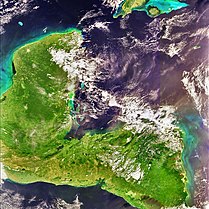|
List of mammals of Central America

This is a list of the native wild mammal species recorded in Central America. Central America is usually defined as the southernmost extension of North America; however, from a biological standpoint it is useful to view it as a separate region of the Americas. Central America is distinct from the remainder of North America in being a tropical region, part of the Neotropical realm, whose flora and fauna display a strong South American influence. The rest of North America is mostly subtropical or temperate, belongs to the Nearctic realm, and has far fewer species of South American origin. At present Central America bridges North and South America, facilitating migrations in both directions, but this phenomenon is relatively recent from a geological perspective. The formation of this land bridge through volcanic activity three million years ago precipitated the Great American Interchange, an important biogeographical event. In part because of this history, Central America is extremely biodiverse; it comprises most of the Mesoamerican biodiversity hotspot.[1] The mountains running down the spine of Central America have also contributed to biodiversity by creating montane habitats, including cloud forests and grasslands, and by separating species from the lowlands along the Pacific and Caribbean coasts. However, Central America's biodiversity suffered a blow in the Quaternary extinction event, which started around 12,500 cal BP, at roughly the time of arrival of Paleoindians; much of the megafauna died out at this time. The effects of modern human activities on climate and ecosystem integrity pose a further threat to Central America's fauna. This list consists of those mammal species found from the Isthmus of Tehuantepec to the northwestern border of Colombia, a region including the Mexican states of Chiapas, Tabasco, Campeche, Yucatán and Quintana Roo, and the nations of Belize, Guatemala, El Salvador, Honduras, Nicaragua, Costa Rica and Panama. As of May 2012, the list contains 378 species, 177 genera, 47 families and 13 orders. Of the taxa from nonflying, nonmarine groups (203 species, 91 genera, 31 families and 10 orders), those of South American origin (opossums, xenarthrans, monkeys and caviomorph rodents) comprise 21% of species, 34% of genera, 52% of families and 50% of orders. Thus, South America's contribution to Central America's biodiversity is fairly modest at the species level, but substantial at higher taxonomic levels. In comparison to South America, a famously biodiverse continent, Central America has 27% as many species, 51% as many genera, 81% as many families and 86% as many orders (considering noncetacean taxa only), while having only 4.3% of the land area. Of the species, two are extinct, eleven are critically endangered, thirteen are endangered, twenty are vulnerable, twenty are near threatened, thirty-five are data deficient and five are not yet evaluated.[n 1] Mammal species presumed extinct since AD 1500 (two cases) are included. Domestic species and introduced species are not listed. Note: this list is almost inevitably going to be incomplete, since new species are continually being recognized via discovery or reclassification. Places to check for missing species include the Wikipedia missing mammal species list, including recently removed entries, and the species listings in the articles for mammalian genera, especially those of small mammals such as rodents or bats. The following tags are used to highlight each species' conservation status as assessed by the International Union for Conservation of Nature; those on the left are used here, those in the second column in some other articles:
The IUCN status of the listed species was last updated between November 2008 and March 2009. Subclass: Theria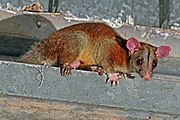   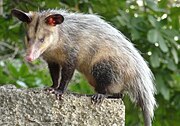   Infraclass: MetatheriaMarsupials are an infraclass of pouched mammals that was once more widely distributed. Today they are found primarily in isolated or formerly isolated continents of Gondwanan origin. Those of Central America are relatively recent immigrants from South America. Central America's 10 extant genera compares with 22 in South America, 1 in North America north of Mexico, 52 in Australia, 28 in New Guinea and 2 in Sulawesi. South American marsupials are thought to be ancestral to those of Australia and elsewhere. Superorder: AmeridelphiaOrder: Didelphimorphia (common opossums)Didelphimorphia is the order of common opossums of the Western Hemisphere. Opossums probably diverged from the basic South American marsupials in the late Cretaceous or early Paleocene. They are small to medium-sized marsupials, about the size of a large house cat, with a long snout and prehensile tail.
Infraclass: EutheriaSuperorder AfrotheriaOrder: Sirenia (manatees and dugongs) Sirenia is an order of fully aquatic, herbivorous mammals that inhabit rivers, estuaries, coastal marine waters, swamps, and marine wetlands. All four extant species are endangered. They evolved about 50 million years ago, and their closest living relatives are elephants. The manatees are the only extant afrotherians in the Americas. However, a number proboscid species, some of which survived until the arrival of Paleoindians, once inhabited the region. Mammoths, mastodons and gomphotheres all reached Central America.
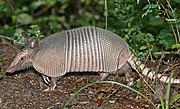     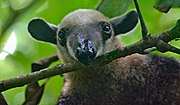 Superorder XenarthraOrder: Cingulata (armadillos)The armadillos are small mammals with a bony armored shell. Two of 21 extant species are present in Central America; the remainder are only found in South America, where they originated. Their much larger relatives, the pampatheres and glyptodonts, once lived in North and South America but became extinct following the appearance of humans.
Order: Pilosa (sloths and anteaters)The order Pilosa is confined to the Americas and contains the tree sloths and anteaters (which include the tamanduas). Although their ancestral home is South America, all 5 extant genera and 6 of 10 extant species are present in Central America. Numerous ground sloths, some of which reached the size of elephants, were once present in both North and South America, as well as on the Antilles, but all went extinct following the arrival of humans. Extant two-toed sloths are more closely related to some extinct ground sloths than to three-toed sloths.
Superorder EuarchontogliresOrder: Primates      The order Primates includes the lemurs, monkeys, and apes, with the latter category including humans. It is divided into four main groupings: strepsirrhines, tarsiers, monkeys of the New World (parvorder Platyrrhini), and monkeys and apes of the Old World. Central America's 6 genera of nonhuman primates compares with 20 in South America, 15 in Madagascar, 23 in Africa and 19 in Asia. Central American monkeys are recent immigrants from South America, where their ancestors arrived after rafting over from Africa 25 million years ago.
Order: Rodentia (rodents)     Rodents make up the largest order of mammals, with over 40% of mammalian species. They have two incisors in the upper and lower jaw which grow continually and must be kept short by gnawing. Most rodents are small, although the capybara can weigh up to 45 kg (99 lb). Central America's 11 species of caviomorph rodents (10% of its total rodent species) are recent immigrants from South America, where their ancestors washed ashore after rafting across the Atlantic from Africa over 30 million years ago.[2] The remainder of Central America's rodents are of Nearctic origin. Ancestral sigmodontine rodents[3] apparently island-hopped from Central America to South America 5 or more million years ago,[4][5][6] prior to the formation of the Panamanian land bridge. They went on to diversify explosively, and now comprise 60% of South America's rodent species, while only making up 27% of Central America's.[n 2]
 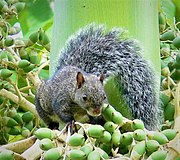 
   
Order: Lagomorpha (lagomorphs)  The lagomorphs comprise two families, Leporidae (hares and rabbits), and Ochotonidae (pikas). Though they can resemble rodents, and were classified as a superfamily in that order until the early 20th century, they have since been considered a separate order. They differ from rodents in a number of physical characteristics, such as having four incisors in the upper jaw rather than two. Central America's lagomorph diversity is considerably less than that of Mexico as a whole, but is greater than that of South America.
Superorder LaurasiatheriaOrder: Eulipotyphla (shrews, hedgehogs, moles, and solenodons)Eulipotyphlans are insectivorous mammals. Shrews and solenodons closely resemble mice, hedgehogs carry spines, while moles are stout-bodied burrowers. Central America's shrew diversity is comparable to that of Mexico as a whole, and is considerably greater than that of South America. Moles are not found in the Americas south of northern Mexico.
Order: Chiroptera (bats)    The bats' most distinguishing feature is that their forelimbs are developed as wings, making them the only mammals capable of flight. Bat species account for about 20% of all mammals.
  
 
        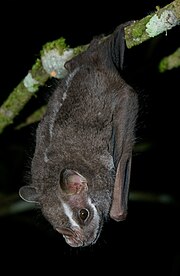     
Order: Carnivora (carnivorans)          There are over 260 species of carnivorans, the majority of which feed primarily on meat. They have a characteristic skull shape and dentition. All of Central America's terrestrial carnivorans are of Nearctic origin. Central America has the greatest diversity of procyonids in the world. Large extinct carnivorans that lived in the area prior to the coming of humans include the saber-toothed cat Smilodon fatalis, the scimitar cat Homotherium serum, American lions, dire wolves and short-faced bears.
Order: Perissodactyla (odd-toed ungulates) The odd-toed ungulates are browsing and grazing mammals. They are usually large to very large, and have relatively simple stomachs and a large middle toe. While native equids once lived in the region, having evolved in North America over a period of 50 million years, they died out around the time of the first arrival of humans, along with at least one ungulate of South American origin, the notoungulate, Mixotoxodon. Sequencing of collagen from a fossil of one recently extinct notoungulate has indicated that this order was closer to the perissodactyls than any extant mammal order.[8]
Order: Artiodactyla (even-toed ungulates and cetaceans)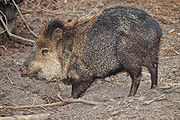   The weight of even-toed ungulates is borne about equally by the third and fourth toes, rather than mostly or entirely by the third as in perissodactyls. There are about 220 noncetacean artiodactyl species, including many that are of great economic importance to humans. All of Central America's extant ungulates are of Nearctic origin. Prior to the arrival of humans, Nearctic camelids also lived in the region.
Infraorder: Cetacea (whales, dolphins and porpoises)        The infraorder Cetacea includes whales, dolphins and porpoises. They are the mammals most fully adapted to aquatic life with a spindle-shaped nearly hairless body, protected by a thick layer of blubber, and forelimbs and tail modified to provide propulsion underwater. Their closest extant relatives are the hippos, which are artiodactyls, from which cetaceans descended; cetaceans are thus also artiodactyls.
See also
Notes
References
Lists of Western Hemisphere mammals from north to south |
Portal di Ensiklopedia Dunia
